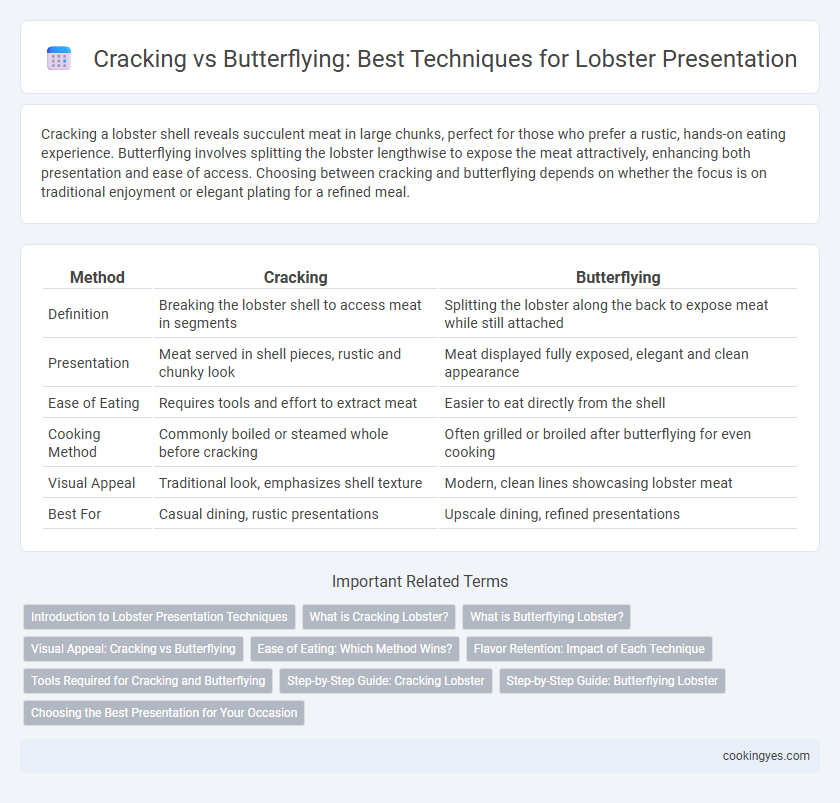Cracking a lobster shell reveals succulent meat in large chunks, perfect for those who prefer a rustic, hands-on eating experience. Butterflying involves splitting the lobster lengthwise to expose the meat attractively, enhancing both presentation and ease of access. Choosing between cracking and butterflying depends on whether the focus is on traditional enjoyment or elegant plating for a refined meal.
Table of Comparison
| Method | Cracking | Butterflying |
|---|---|---|
| Definition | Breaking the lobster shell to access meat in segments | Splitting the lobster along the back to expose meat while still attached |
| Presentation | Meat served in shell pieces, rustic and chunky look | Meat displayed fully exposed, elegant and clean appearance |
| Ease of Eating | Requires tools and effort to extract meat | Easier to eat directly from the shell |
| Cooking Method | Commonly boiled or steamed whole before cracking | Often grilled or broiled after butterflying for even cooking |
| Visual Appeal | Traditional look, emphasizes shell texture | Modern, clean lines showcasing lobster meat |
| Best For | Casual dining, rustic presentations | Upscale dining, refined presentations |
Introduction to Lobster Presentation Techniques
Cracking lobster involves breaking the shell into larger pieces to expose the meat, offering a rustic and hands-on dining experience favored in casual seafood settings. Butterflying lobster requires splitting the lobster lengthwise and spreading it open, creating an elegant presentation that highlights the meat's texture and color, often preferred in fine dining. Both techniques enhance flavor absorption and ease of eating, but choosing between cracking and butterflying depends on the desired visual impact and dining style.
What is Cracking Lobster?
Cracking lobster involves breaking the shell into manageable pieces to expose the meat while keeping the claw or leg largely intact for a rustic presentation. This method highlights the natural texture and flavors by allowing diners to extract meat directly from the shell using their hands or special tools. Cracking lobster is preferred for a tactile dining experience and showcases the seafood's freshness and succulence.
What is Butterflying Lobster?
Butterflying lobster involves slicing the shell down the middle of the back and opening it like a book to expose the meat, creating an elegant presentation that enhances both flavor absorption and visual appeal. This technique contrasts with cracking, which breaks the shell into pieces to access the meat but often results in scattered shell fragments and less uniform cooking. Butterflied lobster allows for even seasoning, faster grilling or broiling, and a more impressive plating suitable for gourmet dishes.
Visual Appeal: Cracking vs Butterflying
Butterflying lobster enhances its visual appeal by showcasing the entire tail and claws, creating an elegant, open presentation that highlights the vibrant red shell and succulent meat. Cracking lobster, while practical, results in a more fragmented look that can detract from the lobster's natural form and vibrant color contrast. For gourmet plating and fine dining, butterflied lobsters provide a striking, chef-worthy aesthetic that elevates the dish's overall presentation.
Ease of Eating: Which Method Wins?
Cracking lobster shells allows for straightforward access to meat but can be messy and requires tools, while butterflying creates an open, visually appealing presentation with easier meat extraction using just a fork. Butterflying enhances ease of eating by exposing large chunks of tender meat, reducing the need for shell removal during the meal. For diners prioritizing convenience and a refined experience, butterflying consistently wins in ease of eating compared to cracking.
Flavor Retention: Impact of Each Technique
Cracking lobster shells allows juices and natural flavors to escape, potentially reducing flavor retention during cooking and serving. Butterflying lobster involves splitting the tail shell lengthwise, exposing the meat directly to heat and seasonings, which helps lock in moisture and intensify flavor absorption. Choosing butterflying over cracking enhances the overall taste experience by preserving the lobster's rich, succulent taste and texture.
Tools Required for Cracking and Butterflying
Cracking lobster requires specialized tools such as lobster crackers, nutcrackers, or seafood picks designed to break the hard shell without damaging the meat inside. Butterflying demands a sharp, sturdy chef's knife or kitchen shears to split the lobster body lengthwise, exposing the tail meat for an elegant presentation. Both methods rely on precise tools aimed at maximizing meat accessibility while enhancing the overall dining experience.
Step-by-Step Guide: Cracking Lobster
Cracking lobster involves carefully breaking the shell to access the meat while maintaining its natural shape, enhancing presentation and flavor. Begin by twisting off the claws and using a nutcracker or lobster cracker to gently crack the shells without crushing the meat inside. Next, use kitchen shears to cut along the lobster's tail, allowing easy removal of the tail meat while preserving the lobster's visual appeal for an elegant presentation.
Step-by-Step Guide: Butterflying Lobster
Butterflying a lobster involves splitting the shell along the back to expose the meat, enhancing presentation and cooking evenness. Start by placing the lobster belly-side down, using kitchen shears to cut from the tail to the head along the centerline. Gently open the shell without detaching the meat, allowing it to lie flat for an elegant display and quicker, more uniform grilling or broiling.
Choosing the Best Presentation for Your Occasion
Cracking lobster shells offers a rustic, hands-on dining experience ideal for casual gatherings and seafood boils. Butterflying lobster presents an elegant, visually appealing option perfect for formal dinners or plated service, showcasing the tender meat fully exposed. Selecting between cracking and butterflying depends on the occasion's atmosphere, desired ease of eating, and presentation style.
Cracking vs Butterflying for lobster presentation Infographic

 cookingyes.com
cookingyes.com